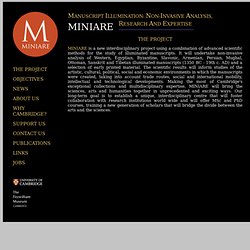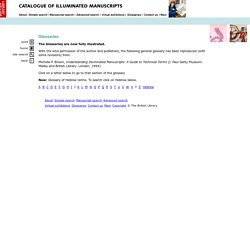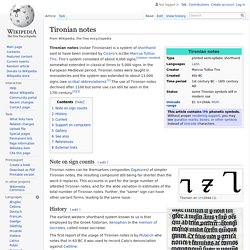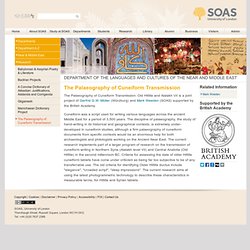Zoom
Trash

The Project. The Project MINIARE is a new interdisciplinary project using a combination of advanced scientific methods for the study of illuminated manuscripts.

It will undertake non-invasive analysis of Western, Egyptian, Byzantine, Slavonic, Armenian, Persian, Mughal, Ottoman, Sanskrit and Tibetan illuminated manuscripts (1350 BC - 19th c. AD) and a selection of early printed material. The scientific results will inform studies of the artistic, cultural, political, social and economic environments in which the manuscripts were created, taking into account trade routes, social and international mobility, intellectual and technological developments. Making the most of Cambridge's exceptional collections and multidisciplinary expertise, MINIARE will bring the sciences, arts and humanities together in unprecedented and exciting ways.
Martinellus. Glossary for the British Library Catalogue of Illuminated Manuscripts. The Glossaries are now fully illustrated.

With the kind permission of the author and publishers, the following general glossary has been reproduced (with some revisions) from: Michelle P. Brown, Understanding Illuminated Manuscripts: A Guide to Technical Terms (J. Paul Getty Museum: Malibu and British Library: London, 1994) Click on a letter below to go to that section of the glossary New: Glossary of Hebrew terms. A B C D E F G H I J K L M N O P Q R S T U V W X Y Z Hebrew. Vocabulaire codicologique. Scribal abbreviation. Text sample from an early 15th-century Bible manuscript.

Scribal abbreviations, or sigla (singular: siglum and sigil) are the abbreviations used by ancient and medieval scribes writing in Latin, and later in Greek and Old Norse. Modern manuscript editing (substantive and mechanical) employs sigla as symbols indicating the location of a source manuscript and to identify the copyist(s) of a work. History[edit] To learn the Tironian note system, scribes required formal schooling in some 4,000 symbols; by the Classical period (c. 7th century BC to 5th century AD), the number increased to some 5,000 symbols, then to some 13,000 in the medieval period (4th to 15th centuries AD);[2] to date, the denotations of some characters remain uncertain. Sigla are mostly for lapidary inscription; in certain late historical periods (e.g. medieval Spain), scribal abbreviations were over-used to the extent that some are indecipherable. Forms[edit] Scribal sigla in modern use[edit] Latin alphabet[edit] General pure. Tironian notes.
Tironian notes (notae Tironianae) is a system of shorthand said to have been invented by Cicero's scribe Marcus Tullius Tiro.

Tiro's system consisted of about 4,000 signs,[citation needed] somewhat extended in classical times to 5,000 signs. In the European Medieval period, Tironian notes were taught in monasteries and the system was extended to about 13,000 signs (see scribal abbreviations).[1] The use of Tironian notes declined after 1100 but some use can still be seen in the 17th century.[2][3] Note on sign counts[edit] Two Tironian et in context (second line from the top and third line from bottom), from a Bible written by a Belgian scribe.
Tironian notes can be themselves composites (ligatures) of simpler Tironian notes, the resulting compound still being far shorter than the word it replaces. History[edit] Manuscript Studies: Paleography: Scribal Abbreviations. Www.cei.lmu.de/extern/VocCod/WOR10-3.pdf. Www.cei.lmu.de/extern/VocCod/WOR10-2.pdf. Www.cei.lmu.de/extern/VocCod/WOR10-1.pdf. Guindo.pntic.mec.es/jmag0042/LATIN_PALEOGRAPHY.pdf. The Palaeography of Cuneiform Transmission. The Palaeography of Cuneiform Transmission The Palaeography of Cuneiform Transmission: Old Hittite and Alalakh VII is a joint project of Gerfrid G.W.

Müller (Würzburg) and Mark Weeden (SOAS) supported by the British Academy Cuneiform was a script used for writing various languages across the ancient Middle East for a period of 3,500 years. The discipline of palaeography, the study of hand-writing in its historical and geographical contexts, is extremely under-developed in cuneiform studies, although a firm palaeography of cuneiform documents from specific contexts would be an enormous help for both archaeologists and philologists working on the Ancient Near East. The current research implements part of a larger program of research on the transmission of cuneiform writing in Northern Syria (Alalakh level VII) and Central Anatolia (Old Hittite) in the second millennium BC. Digital Resource for Palaeography. Evellum - Home. Welcome to the Parker Library on the Web. Medieval Writing.